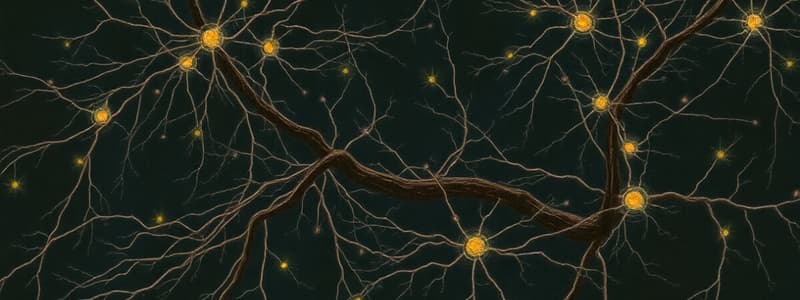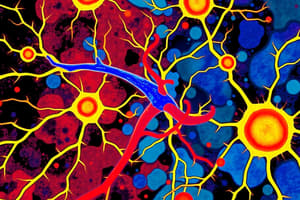Podcast
Questions and Answers
What are neurons?
What are neurons?
Neurons are the basic information-processing structures in the CNS that are electrically excitable cells processing and transmitting information.
Which types of neurons transmit information to the central nervous system from sensory receptors?
Which types of neurons transmit information to the central nervous system from sensory receptors?
- Afferent neurons (correct)
- Interneurons
- Efferent neurons
- Mixed neurons
The resting potential of a neuron is about ______ millivolts.
The resting potential of a neuron is about ______ millivolts.
-40
The action potential of a neuron always varies in size.
The action potential of a neuron always varies in size.
What is the function of oligodendrocytes?
What is the function of oligodendrocytes?
What happens during depolarization in a neuron?
What happens during depolarization in a neuron?
Match the following types of glial cells with their functions:
Match the following types of glial cells with their functions:
Flashcards are hidden until you start studying
Study Notes
Neurons
- Neurons are the basic building blocks of the central nervous system (CNS).
- They transmit information via electrical or chemical signals.
- A typical neuron has three main parts:
- Cell body (soma): The central region containing the nucleus.
- Dendrites: Branching extensions that receive signals from other neurons.
- Axon: A long, slender projection that transmits signals to other neurons or cells.
Types of Neurons
- Efferent neurons (motor neurons): Carry signals from the brain to muscles and glands.
- Afferent neurons (sensory neurons): Transmit signals from sensory receptors to the CNS.
- Interneurons: Found within the CNS, connect and transmit information between motor and sensory neurons.
- Mixed neurons: Possess characteristics of both motor and sensory neurons.
Glial Cells
- Glial cells support and maintain the nervous system.
- They provide structural integrity, nutrition, and help regulate the environment around neurons.
Types of Glial Cells
- Oligodendrocytes (CNS): Form myelin sheaths around axons in the CNS, increasing signal transmission speed.
- Schwann cells (PNS): Insulate a single axon in the peripheral nervous system (PNS) with myelin.
- Astrocytes (CNS): Maintain the chemical environment surrounding neurons.
- Microglia (CNS): Serve as the immune system of the CNS, acting as specialized macrophages.
Neural Impulse: Resting Potential
- Resting potential is the electrical charge difference across the neuron membrane when it's not actively transmitting information.
- The inside of the neuron is more negatively charged than the outside, typically around -40 millivolts (mV).
- This difference is due to the higher concentration of positive ions (sodium, Na+) outside the cell and more potassium (K+) inside the cell.
Neural Impulse: Action Potential
- An action potential is a rapid change in the membrane potential, allowing information transmission within the nervous system.
- When a neuron receives a stimulus, sodium (Na+) channels open, and Na+ rushes into the cell, causing depolarization.
- Depolarization reduces the negative charge inside the neuron.
- If depolarization reaches a threshold level (around +55 mV), an action potential is triggered.
- The size of the action potential is always the same for a given neuron (all-or-nothing principle).
Action Potential Steps
- Depolarization: The influx of Na+ makes the inside of the cell more positive.
- Repolarization: Potassium (K+) channels open, and K+ flows out of the cell, restoring the negative charge.
- Hyperpolarization: Brief period where the membrane potential becomes more negative than resting potential.
- Return to resting potential: The sodium-potassium pump actively pumps Na+ out and K+ back in to restore the original concentration gradient.
Studying That Suits You
Use AI to generate personalized quizzes and flashcards to suit your learning preferences.




